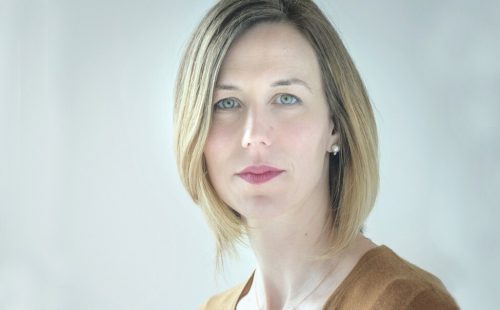
BY JUDY CARMACK BROSS
Many people think the Hyde Park Art Center is a neighborhood center. It is actually the largest cultural institution exhibiting Chicago artists exclusively. This has made it incredibly influential for the local scene and beyond. ts support of our creative community has boosted and launched careers of countless internationally acclaimed artists which has generated fierce loyalty. –Photographer Brooke Hummer
From a defunct saloon to a dance studio to the Del Prado apartments and finally to a sleek space by cutting-edge architect Doug Garofalo, the 10 different locations of the Hyde Park Art Center read like a road map of its beloved neighborhood: Blackstone Avenue, Cable Court, Hyde Park Blvd, 57th and 55th Streets, and now Cornell Avenue.
Artists who exhibited there early in their career have flourished on a national and international scale: Roger Brown, Ed Paschke, James Marshall, Ruth Duckworth, Juan Angel Chavez, and Dawoud Bey, who now serves as a member of its board of directors.
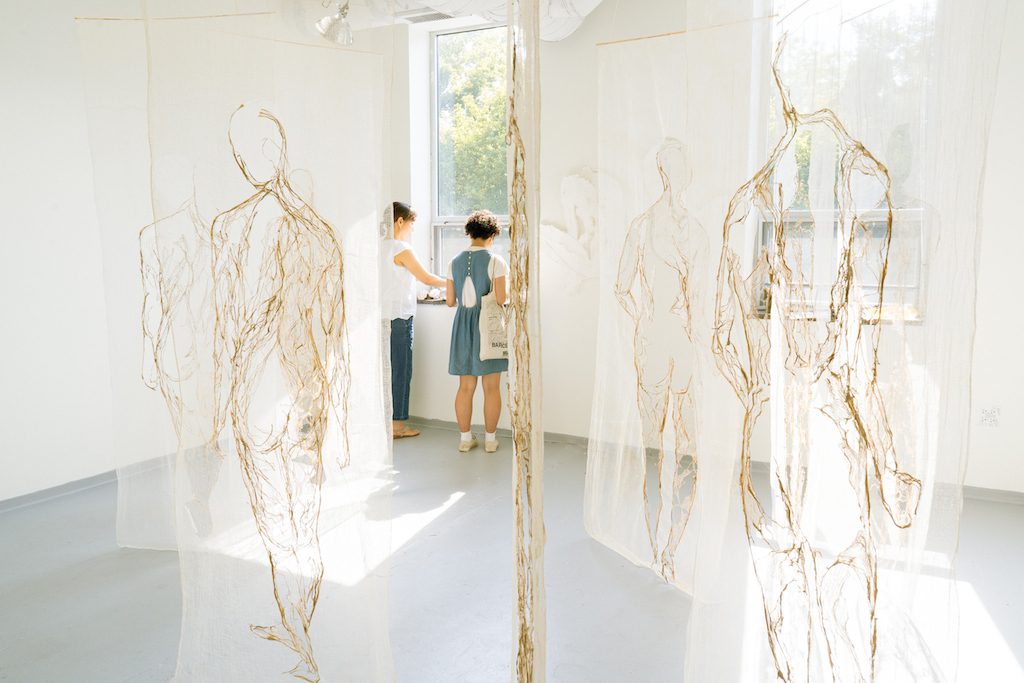
An exhibition as part of the center’s 80th anniversary.
Opened in June 1939, it was originally called the Fifth Ward Art Center of Chicago, Illinois, but the name was soon changed to the Hyde Park Art Center. Its founders, who included future Senator Paul Douglas, consisted primarily of artists and volunteers committed to creating a neighborhood space for the visual arts. The Art Center’s first home was a former saloon next door to then-alderman Douglas’s constituent office at 1466 E. 57th Street.



The 80th anniversary of the Hyde Park Art Center celebrates a place as vibrant and giving as any institution representative of Chicago’s own fiery reputation for creativity. Former board member Brooke Hummer, current board chair Justine Jentes, and executive director Kate Lorenz spoke with us recently about why HPAC is a key contributor to Chicago’s thriving art community and why it is a model for other organizations across the city and country.
Lorenz described the center as “a real hub—one of those third places in addition to home and work where artists can interact with other people, a social space and a creative one. In addition, it is a goal engine for artists.”
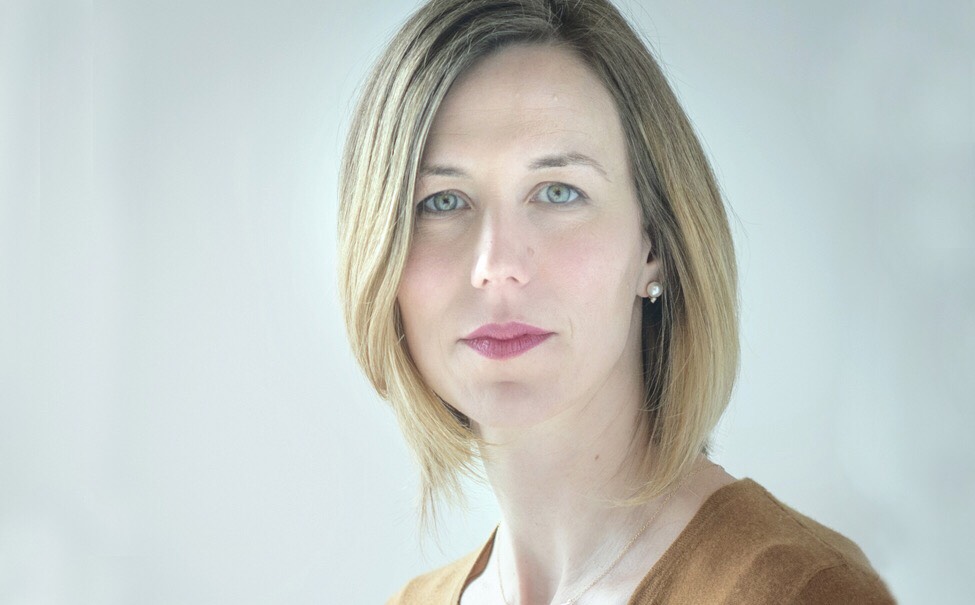
Kate Lorenz.
Joining HPAC 17 years ago as an intern, Lorenz has been executive director for 10 years. She describes the recent festival birthday celebration as a gift to the community—an opportunity for artists, young adults, and friends to come together for lots of creativity and fun—following up on the fantastic public events offered throughout the year. Providing adventures such as “cocktails and clay” featuring a live DJ, cash bar, and ceramics; the ArtThing, inviting chats with exhibiting artists; Second Sunday, presenting family-oriented fun; and the informal discussion groups of Talking Point, bringing in guests from across the city.
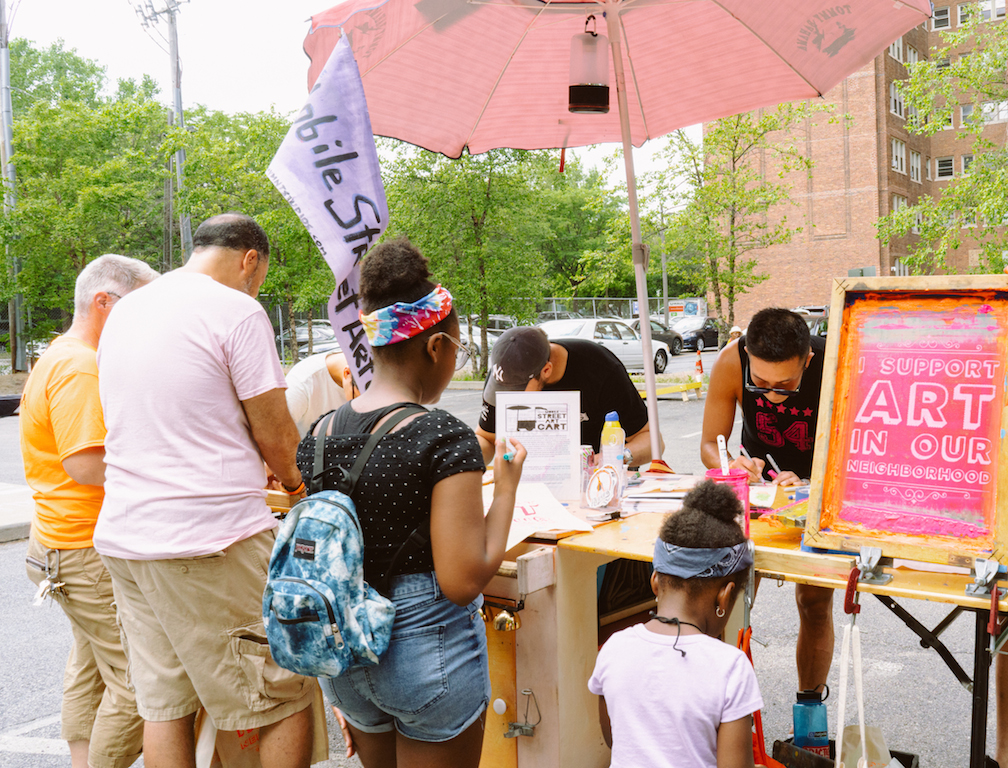
On-site screen printing.
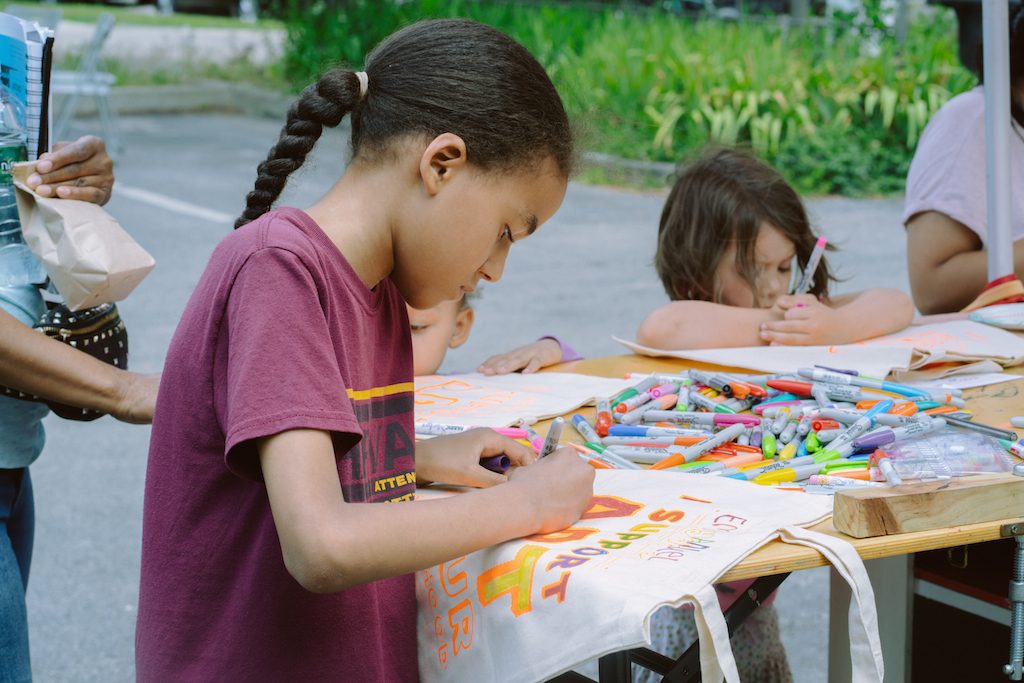
One of many kid’s art activities at the 80th celebration.
HPAC primarily exhibits work by emerging or under-recognized contemporary artists living in Chicago and does not maintain a permanent collection.
Justine Jentes, a member of Exelon’s corporate relations team and herself an artist, talked to us about her involvement with the HPAC: “It has been a gathering place and has worked at being an inclusive community in a city segregated by race, ethnicity, economics, and geography. I appreciate that whenever I visit, I see such a wide variety of people: families, teens, up-and-coming artists, well-established artists, curators, art makers who don’t call themselves artists, collectors, coffee drinkers, etc, etc, etc. HPAC welcomes everyone and the gifts that everyone brings—Kate and the staff are wonderfully willing to hear ideas, collaborate, give something new/different a try.”
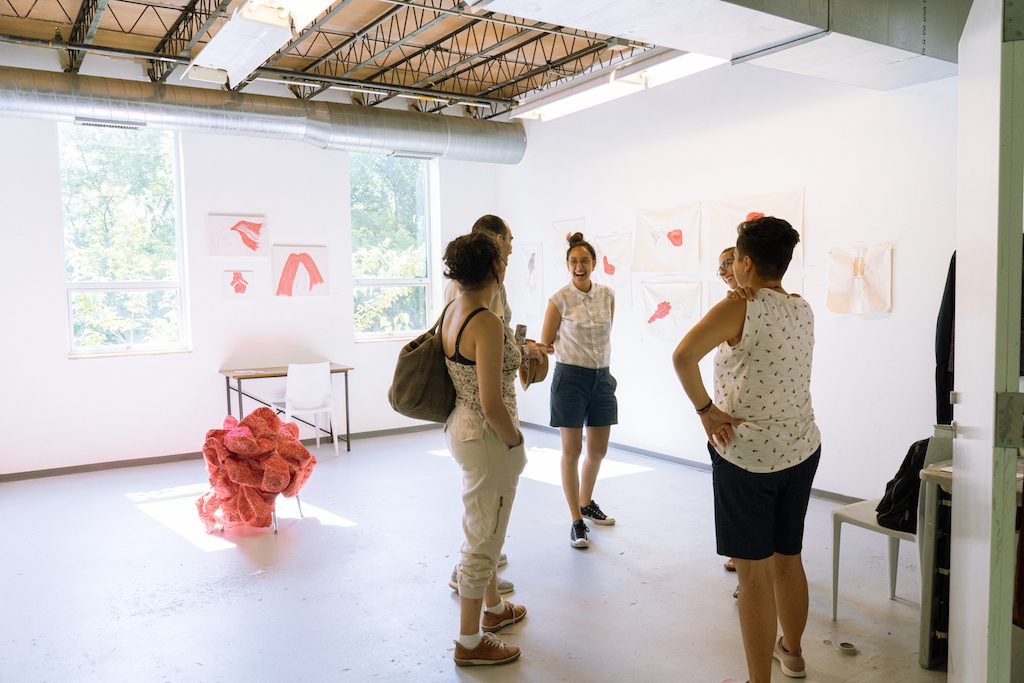
She recalls a panel discussion a little over a year ago: “Artist Susan Giles listed the many times HPAC had opened doors for her during her residency and exhibition. She felt that the center was continuously looking for ways to help her grow as an artist and connect her to collectors, curators and new opportunities. This seemed far above and beyond what might happen at other galleries or museums.”
“Several years ago,” she continued, “I was so excited about the John Preus installation. It was a great example of the kind of collaboration and risk HPAC is willing to take on, without really knowing what will develop. I was moved by the very diverse people who started using the space, not necessarily as a gallery or because of the art—teens had a sort of clubhouse where they started hanging out, there was a community group that met about redevelopment issues.”
Jentes is particularly proud of the center’s initiative to widen its reach through a community-supported school, increased—and hopefully viable—pay for teaching artists, and investments in exhibiting artists’ visions. “As we succeed in these areas,” she says, “we’ll provide a model for other organizations across the city and the country.”
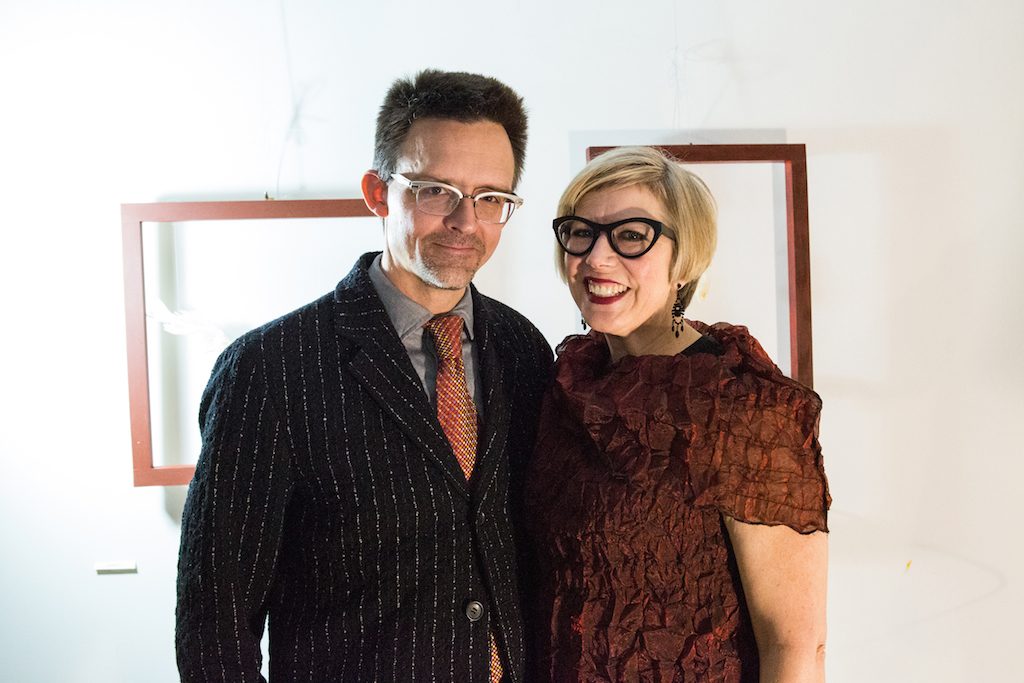
Justine Jentes with husband Daniel Kuruna. Photo by Claire Demos.
One of Chicago’s top photographers, whose portraits profile all ages, Brooke Hummer told us about how she first came to HPAC: “I fell in love with HPAC as an artist in my 20s when they were located in the Del Prado building. They had a small space but a big heart and—as now—a mission of connecting emerging and established artists and patrons in Chicago. I joined their board for a few years to help out when they started the building project on Cornell Avenue. I was enchanted by their vision of creating a center to host studio facilities plus residencies for working artists, teen programming, plus public art education together with exhibit space that features the most cutting edge shows in the city.”
Hummer and her husband, Grove Mower, shared a painting by Hebru Brantley, which they commissioned from the HPAC 2012 “Not Just Another Pretty Face” show, when he worked closely with their sons Chapin and Ned. “Grove and I intentionally stayed away from the collaboration to make it a more meaningful experience for the boys,” she shares. “Hebru is a superstar but also the most genuine, generous, and lovely person in the world! Through the years, Grove and I have commissioned four paintings with ‘Not Just Another Pretty Face.’ ”
She describes the experience as unforgettable, the painting of the two boys as a knight and a Brantley Flyboy, the family’s most beloved treasure.
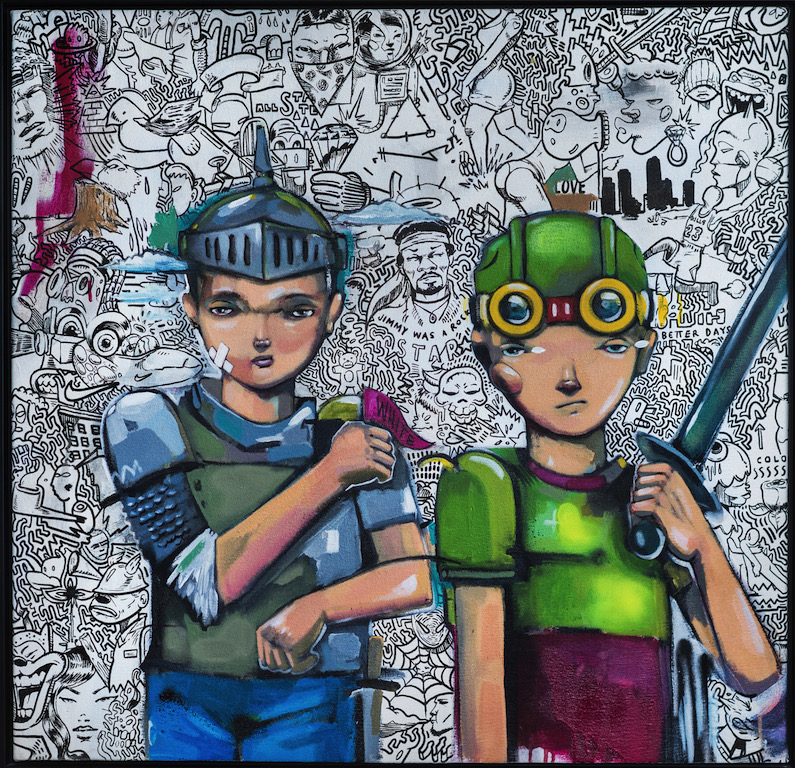
The Hummer family’s Hebru Brantley painting.
“In general, I enjoy their open, generous style of celebrating artists and art lovers. HPAC practices inclusion over exclusion, and that is reflected in their approach to all of their programs and initiatives,” Hummer explains. “Having said that, HPAC values all of their services as much as their relationship to successful, recognized artists. Their discerning sensibility for identifying talent is balanced by their parallel mission of nurturing students and learners of all levels. A great testament to that goal is their recent ambitious campaign to fund all of their programs, making them free to the public. Talk about inclusivity! The center continues to surprise and amaze me.”

Her most recent obsession? Mike Nourse and the Education Outreach Program. HPAC provides teacher training for artists who are then placed (along with curriculum) in south and southwest Chicago schools. With cuts throughout CPS in art education, Hummer believes the work that Nourse and his team are doing has taken on a great sense of urgency and importance.
During the summer, HPAC offers a variety of activity camps for kids, from pre-school age and up. Across 28 Hyde Park schools, they have over 100 participating students. Lorenz says, “We want to develop creative leaders but also just offer a place to hang out. Many like engaging with our artists in residence. Several had the amazing opportunity to work with the muralist Gabriel Villa.”
“Everyone is an artist waiting for the right teacher,” she quotes.
“We have amazing artists from across the neighborhood, region and the world but we have also feel that we have broadened the definition of who gets to be an artist,” Lorenz adds. “Many adults have been told that they don’t know enough to be an artist or they can’t do art. People need a passion and coming back to an early or perhaps thwarted interest in art later in life is something we can help people do.”
To learn more about HPAC, visit hydeparkart.org.



